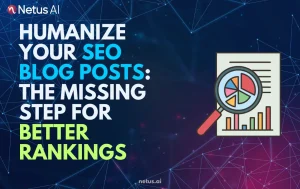
Google’s Helpful Content Update: An SEO Writer’s Guide | NetusAI
SEO Writer’s Guide to Google’s Helpful Content Update Keeping up with Google’s algorithm changes can feel like a relentless game of whack-a-mole. Just when you
Significance of Plagiarism in Australia: Impact on Education and Legal Ramifications

Content writer and editor for Netus.AI
Significance of Plagiarism in Australia. Plagiarism refers to the unauthorized duplication of an author’s work without proper consent. Although specific plagiarism laws may not exist in certain countries, copyright regulations can offer necessary protections for creators.
In Australia, strict punitive measures related to plagiarism may be uncommon, but educational institutions are taking note of its increasing prevalence. According to the NESA, students have been found plagiarizing in exams approximately 50% of the time. As a result, many academic establishments have imposed penalties, such as assigning a grade of zero. This development indicates a growing awareness of plagiarism as a significant offense.
To maintain academic integrity, university students should be diligent in avoiding plagiarism, contract cheating, and other forms of unethical behavior. Upholding these principles is crucial for preserving the credibility of research outputs and the value of higher education qualifications.
In Australia, creators of various artistic works enjoy legal protection through the Copyright Act 1968, which grants them exclusive rights over their creations. This act covers a wide range of artistic creations, such as musical compositions, books, video games, and broadcasts. By preventing unauthorized copying and distribution, this law aims to protect the interests of copyright holders.
An exception to this regulation, known as “fair use,” allows certain uses of copyrighted materials for research, study, and educational purposes. In this context, students can copy a small portion of a work without permission from the copyright holder, as long as it falls under the scope of fair use. However, copying an entire work or significant parts of it is considered plagiarism and goes against academic integrity.
Universities in Australia have established policies to address instances of plagiarism. While not all acts of plagiarism qualify as copyright infringement, it’s essential for students to be careful when using copyrighted materials in their work. An effective way to avoid plagiarism is by acknowledging the original author and properly citing the source.
In order to maintain the highest standards for academic research, Australian universities follow a set of guidelines, known as the “Academic Regulations for Higher Degrees of Research.” These regulations outline research misconduct, including plagiarism, under section 14, specifically article 14.2.
To sum up, it’s crucial for students and researchers in Australia to have a thorough understanding of copyright laws and how they apply to their work. By acknowledging authors and adhering to fair use principles, one can avoid not only plagiarism but also potential legal repercussions related to copyright infringement.
Australia is known for its stable economy, which attracts engineers from all over the world. Moreover, the country offers a higher minimum wage to skilled workers, making it an even more enticing destination. With the Australian government offering various visa categories, many engineers opt for the 12-month working holiday visa.
Upon visa extension, the terms of service can be adapted accordingly. However, in order to secure jobs in Australia, it is crucial for engineers to undergo a CDR assessment. This process ensures that candidates possess the necessary skills for the job and gain access to valuable support services during their stay.
In summary, engineers must be cautious of unreliable agencies and agents, and instead directly apply for jobs and visas through official channels. Proper research and preparation can provide a seamless pathway to working in Australia, while avoiding unnecessary intermediaries.
The Competency Demonstration Report (CDR) holds immense significance for job applicants, as it serves as a valuable tool that goes beyond evaluating individuals solely on their academic qualifications. Companies take into account the applicant’s experience through CDR, which is presented in an engaging essay format, akin to a term paper.
It is not uncommon for candidates to seek assistance from agencies to create their CDRs. However, this poses risks such as receiving plagiarized content in their reports, which can result in disqualification and halted progress. Additionally, the original writer could resort to legal measures to protect their work’s rights, so it is advised to avoid seeking help from external agencies.
By carefully crafting an authentic CDR, job seekers enhance their chances of success and demonstrate their skills and experiences effectively to potential employers.
Paraphrasing and plagiarism are two distinct concepts in academic writing. The key to differentiating them lies in their degree of similarity to the original text. Paraphrasing involves conveying the essence of a source’s ideas using one’s own words and phrasing. It allows students to absorb and present information in a manner that suits their writing style, without directly copying the original text. Nevertheless, proper attribution remains crucial when paraphrasing, as failing to provide appropriate citations may lead to accusations of plagiarism.
On the other hand, plagiarism occurs when someone copies another person’s work without giving proper credit. It is a form of intellectual theft and lying in academic writing, resulting in severe consequences. Hence, students must be cautious and conscientious when using source material, ensuring that they accurately and ethically attribute borrowed ideas.
To effectively paraphrase, writers must:
To avoid plagiarism, students can utilize plagiarism checkers to assess their work. These tools help identify instances where paraphrased content may be too similar to the original, thus assisting students in refining their writing and steering clear of plagiarism.
In conclusion, understanding the distinction between paraphrasing and plagiarism is essential for producing high-quality, ethical, and well-rounded academic work. With appropriate attribution and attentive rephrasing, students can confidently and legitimately incorporate the ideas of others into their own writing.
Universities place significant importance on maintaining academic integrity and detecting plagiarism in students’ submitted work. Consequently, students can benefit from using plagiarism checkers before submitting their assignments, ensuring they avoid any repercussions that could affect their future employment opportunities.
Nowadays, online plagiarism checkers, such as Turnitin and iThenticate, have become reliable tools for students to assess their academic work. These free platforms have access to numerous resources that go beyond conventional search engines, allowing for faster and more accurate comparisons.
Employing search engines for manual plagiarism detection can often yield imperfect results and can be considerably time-consuming. In contrast, online plagiarism checkers can instantly identify duplicated portions of text, rendering the process more efficient. Additionally, these tools calculate the percentage of plagiarized content in the submitted work, a useful indicator for students who have paraphrased information.
To ensure the proper attribution of sources and prevent plagiarism, students can use quotation marks and citations to reference any borrowed material. This practice not only helps to maintain academic honesty but also aids in achieving higher grades and fostering a positive impression when working in countries like Australia.
In summary, using plagiarism checkers is essential for students and professionals alike. These tools play a vital role in promoting transparency and avoiding plagiarism in educational and professional settings. By leveraging the capabilities of online plagiarism checkers, individuals can ensure that their assignments are original and meet the highest standards of academic integrity.
Plagiarism can lead to serious consequences in Australian academia, such as receiving a failing grade, suspension, or even expulsion from the institution. Furthermore, it can damage students’ academic reputation and future educational or professional opportunities.
Plagiarism can potentially lead to legal issues as well, such as copyright infringement or even fraud if it’s connected to financial gain. In some cases, legal action may be taken against plagiarists.
Academic integrity is crucial to maintaining the quality and reputation of Australian educational institutions. Any instances of plagiarism can question an institution’s commitment to fostering a fair and honest academic environment.
To prevent plagiarism, Australian universities implement strict policies, provide educational resources, and use tools like plagiarism-detection software. They also emphasize the importance of academic integrity and may require students to pledge their work’s originality.
Plagiarism devalues Australian degrees by questioning the credibility of the educational system and undermining genuine efforts by students. This can ultimately lead to decreased confidence in graduates’ abilities and qualifications, impacting the reputation of Australian education globally.
Australian educational institutions invest in advanced software tools to detect and prevent plagiarism. They also develop and distribute guidelines on properly citing sources, avoiding inadvertent plagiarism, and promoting academic honesty. In addition, educators are trained to recognize and address plagiarism occurrences.

SEO Writer’s Guide to Google’s Helpful Content Update Keeping up with Google’s algorithm changes can feel like a relentless game of whack-a-mole. Just when you

Can AI Content Be Safe for SEO in 2025? Let’s start with the question of keeping every content strategist, SEO pro and blogger awake at

Humanize Your SEO Blog Posts: The Missing Step for Better Rankings You’ve done everything by the book. Your keyword research is impeccable. Your meta descriptions

How to Pass AI Detection Tests as an SEO Writer Let’s paint a familiar picture. You’ve just finished a blog post. The headline is sharp,

Why Your AI SEO Blog Isn’t Ranking (And How to Fix It) You embraced AI for your blog. The promise was intoxicating: high-quality content, published

The Modern SEO Writer’s Stack: Tools to Stay Ahead in AI-Powered Search Remember the days when “SEO writing” conjured images of frantic keyword stuffing, awkward
@ 2024 Netus AI.